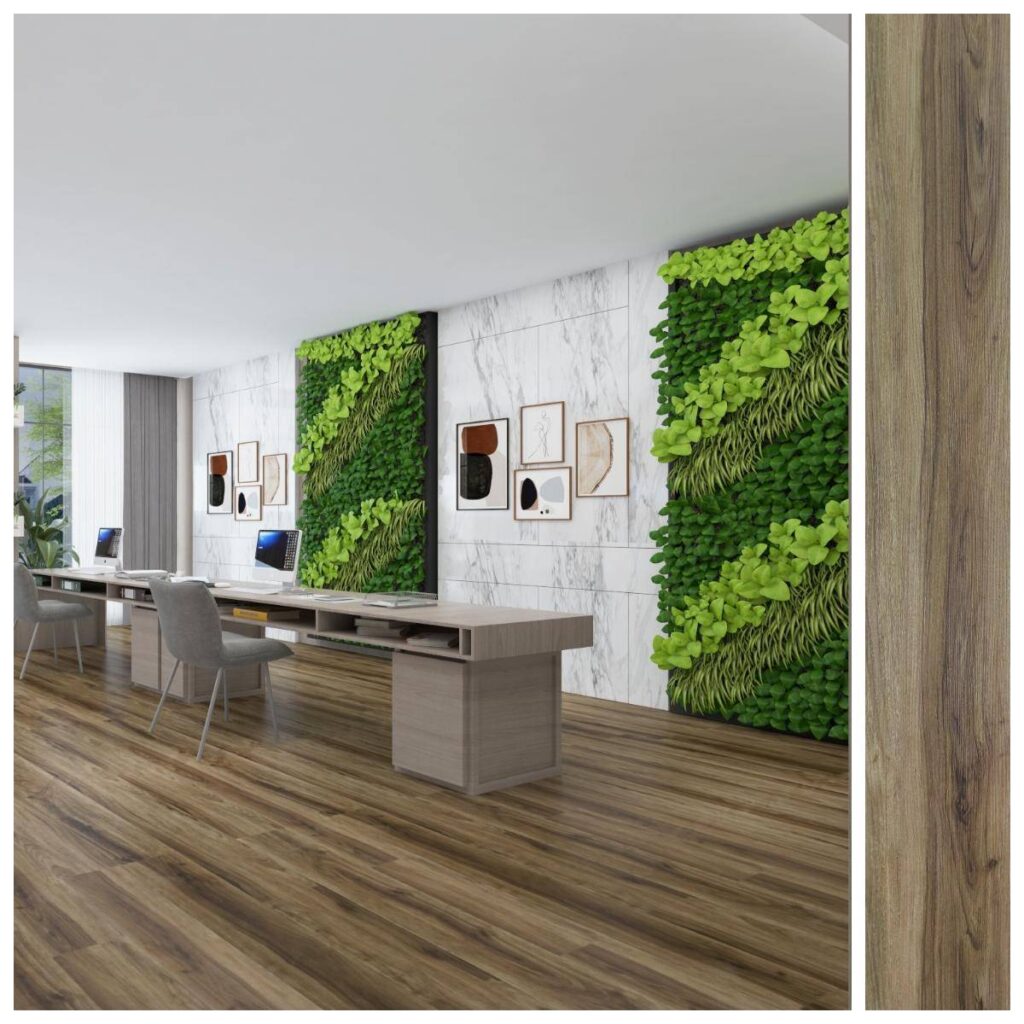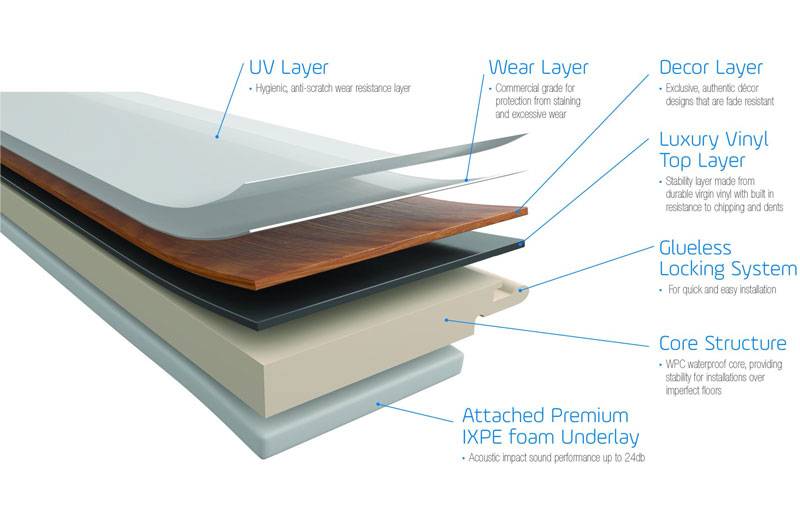Hybrid flooring, also known as engineered rigid core flooring, is a type of flooring that combines the best features of laminate and vinyl flooring. It is designed to be highly durable, waterproof, and resistant to wear and tear.
Hybrid flooring typically consists of several layers. The top layer is a transparent wear layer that provides protection against scratches, stains, and fading. Beneath the wear layer, there is a decorative layer that can replicate the appearance of various materials such as hardwood, stone, or tile. This layer gives hybrid flooring its aesthetic appeal.
The core of hybrid flooring is usually made of a rigid composite material, such as stone plastic composite (SPC) or wood plastic composite (WPC). This core layer provides stability, dimensional strength, and resistance to impacts and indentations. It also contributes to the waterproof properties of hybrid flooring.
The bottom layer of hybrid flooring is often equipped with an underlayment or an attached cork layer, which adds cushioning, reduces noise, and enhances comfort underfoot.
One of the main advantages of hybrid flooring is its ability to withstand moisture and water. It is suitable for installation in areas prone to spills, such as kitchens, bathrooms, and basements. Hybrid flooring is also known for its ease of installation, as it can be installed as a floating floor without the need for adhesives.
Overall, hybrid flooring offers a combination of durability, water resistance, aesthetics, and easy installation, making it a popular choice for residential and commercial spaces.
What Is WPC Flooring ?
WPC flooring stands for Wood Plastic Composite flooring. It is a type of flooring material that combines the durability and aesthetic appeal of hardwood with the water resistance and low maintenance of plastic. WPC flooring is commonly used as an alternative to traditional hardwood flooring, laminate flooring, or vinyl flooring.
The composition of WPC flooring typically consists of a mixture of wood fibers or wood flour, thermoplastics (such as PVC or polyethylene), and various additives. This combination creates a robust and stable flooring material that is resistant to moisture, scratches, stains, and fading. The wood fibers provide a natural and authentic look, while the thermoplastics offer strength and stability.
WPC flooring is available in various styles, colors, and textures, mimicking the appearance of hardwood, stone, or tile. It often comes in the form of interlocking planks or tiles, making it easy to install as a floating floor without the need for adhesives. Some WPC flooring products also feature an attached underlayment, which provides additional comfort and noise reduction.
One of the advantages of WPC flooring is its water resistance. Unlike traditional hardwood flooring, WPC is less susceptible to water damage, making it suitable for areas with high moisture, such as bathrooms, kitchens, and basements. It is also relatively low maintenance, requiring regular sweeping and occasional damp mopping to keep it clean.
Overall, WPC flooring offers a balance between the natural beauty of wood and the practical benefits of synthetic materials, making it a popular choice for residential and commercial applications.
What Is SPC Flooring?
SPC flooring stands for Stone Plastic Composite flooring. It is a type of rigid core flooring that is engineered with a blend of limestone powder, PVC, and stabilizers. SPC flooring is known for its exceptional durability, water resistance, and stability, making it a popular choice for both residential and commercial applications.
The composition of SPC flooring typically includes four layers:
- Wear Layer: This topmost layer is transparent and provides resistance against stains, scratches, and wear. It helps protect the flooring from daily use and prolongs its lifespan.
- Vinyl Layer: The vinyl layer is printed with a decorative design, which can mimic the appearance of hardwood, stone, or other materials. It contributes to the aesthetic appeal of the flooring.
- SPC Core Layer: The SPC core layer is the thickest layer and gives the flooring its rigidity and stability. It is made of a mixture of limestone powder, PVC, and stabilizers. This layer provides dimensional stability, making SPC flooring resistant to expansion and contraction due to temperature and humidity changes.
- Underlayment Layer: Some SPC flooring products come with an attached underlayment layer. This layer provides additional sound insulation, comfort underfoot, and helps smooth out minor imperfections in the subfloor.
SPC flooring has several advantages. It is highly durable and can withstand heavy foot traffic and impacts. It is also resistant to moisture, making it suitable for areas prone to spills, such as kitchens, bathrooms, and basements. Additionally, SPC flooring is easy to install, as it often utilizes a click-lock system that allows for floating installation without the need for adhesives.
Overall, SPC flooring offers a robust and stylish flooring solution that combines the natural look of wood or stone with the practical benefits of a synthetic material.
What Is the Main Difference Between SPC Hybrid and WPC Hybrid Flooring?
The main difference between SPC hybrid and WPC hybrid flooring lies in the core composition and characteristics of the two types.
SPC Hybrid Flooring: SPC hybrid flooring, also known as rigid core hybrid flooring, has a core layer that is primarily composed of Stone Plastic Composite (SPC). This core layer consists of a mixture of limestone powder, PVC, and stabilizers. SPC hybrid flooring is characterized by its high rigidity, strength, and stability. It offers exceptional dimensional stability, making it highly resistant to expansion and contraction due to temperature and humidity changes. SPC hybrid flooring is known for its durability, water resistance, and suitability for high-traffic areas.
WPC Hybrid Flooring: WPC hybrid flooring, also known as wood plastic composite hybrid flooring, has a core layer that is primarily composed of Wood Plastic Composite (WPC). This core layer combines wood fibers or wood flour with thermoplastics (such as PVC or polyethylene) and various additives. WPC hybrid flooring offers a balance between the natural appearance of wood and the practical benefits of synthetic materials. It provides good stability and water resistance, although it may not be as rigid as SPC hybrid flooring.
In summary, the key differences between SPC hybrid and WPC hybrid flooring are:
- Core Composition: SPC hybrid flooring has an SPC core, while WPC hybrid flooring has a WPC core. SPC consists of limestone powder, PVC, and stabilizers, whereas WPC combines wood fibers or wood flour with thermoplastics.
- Rigidity and Stability: SPC hybrid flooring is generally more rigid and stable than WPC hybrid flooring. SPC’s core composition provides excellent dimensional stability, reducing the risk of expansion or contraction. WPC hybrid flooring offers good stability but may have slightly more flexibility compared to SPC.
- Water Resistance: Both SPC hybrid and WPC hybrid flooring are water-resistant. However, SPC hybrid flooring tends to have higher water resistance due to its composition and denser core.
Choosing between SPC hybrid and WPC hybrid flooring depends on individual preferences and specific needs. SPC hybrid flooring is ideal for areas with high moisture or heavy foot traffic, while WPC hybrid flooring offers a balance between natural aesthetics and practicality.
Which rooms is hybrid flooring suited for ?
Hybrid flooring, whether SPC hybrid or WPC hybrid, is well-suited for various rooms in both residential and commercial settings. Its durability, water resistance, and versatility make it a popular choice for different areas of a building. Here are some examples of rooms where hybrid flooring is commonly used:
- Living Room: Hybrid flooring is an excellent choice for living rooms, as it can withstand the high foot traffic and potential spills that may occur in this area. It offers the beauty of hardwood or stone while being more resistant to scratches, stains, and wear compared to traditional materials.
- Kitchen: Hybrid flooring is well-suited for kitchens due to its water resistance and easy maintenance. It can handle spills, moisture, and occasional water splashes without warping or deteriorating. Its durable surface makes it suitable for the demands of a busy kitchen environment.
- Bathroom: Both SPC hybrid and WPC hybrid flooring are suitable for bathrooms. Their water resistance properties make them ideal for areas prone to moisture. However, it’s important to note that proper installation and sealing of edges are crucial to prevent water infiltration, especially in areas near showers or bathtubs.
- Basement: Basements can be susceptible to moisture, so hybrid flooring is a great choice due to its water resistance. It helps create a comfortable and inviting space while minimizing the risk of damage from potential basement moisture issues.
- Entryways and Mudrooms: Entryways and mudrooms often experience heavy foot traffic, dirt, and wet shoes. Hybrid flooring’s durability and water resistance make it an excellent option to handle these conditions while maintaining a visually appealing and clean look.
- Retail Stores and Offices: Hybrid flooring is commonly used in commercial spaces such as retail stores and offices. It can withstand the constant movement of people, rolling chairs, and the need for easy maintenance. It also offers a range of design options to create an attractive and professional environment.
In general, hybrid flooring can be installed in any room where you desire a durable, water-resistant, and visually appealing flooring solution. It provides versatility and performance that make it suitable for various applications throughout a building



